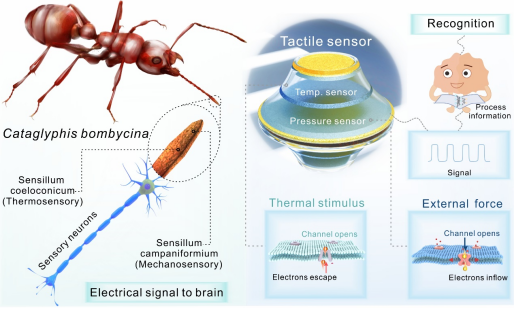Recently, the group of “Advanced Wood Fiber Materials” in the School of Light Industry and Food Engineering of the University has made great progress in the field of paper-based functional materials, and the research results have been published in the top international academic journal Nature Communications under the title of “Triboelectric tactile sensor for pressure and temperature sensing in high-temperature applications”. The first author of the paper is Liu Yanhua, a PhD student of the class of 2022, and the corresponding author is Nie Shuangxi, a professor of the School of Light Industry and Food Engineering. Guangxi University is the only completion unit of the paper.

Frictional nanostructured power generation technology, with its unique working mechanism, provides an innovative way to develop new environmentally adaptive tactile sensors. By means of this technology, paper-based functional materials show unique advantages and broad application prospects. As an excellent friction electric material, paper not only possesses environmentally friendly characteristics such as renewable, degradable and biocompatible, but more importantly, the hydroxyl groups on the β-D-glucopyranose ring in its molecular structure endow the material with excellent polarization properties and its intrinsic high temperature resistance, which make paper-based friction electric materials irreplaceable in the field of high-temperature tactile sensing, and are expected to become the ideal choice for replacing the traditional petroleum-based synthetic polymers. Based on the high-temperature resistance and friction electric properties of cellulose, this study has solved the problem of signal attenuation of traditional anode polymer friction electric materials at high temperatures by regulating carrier mobility, which provides a new idea for the construction of a new generation of pressure-temperature synergistic sensing systems at high-temperature.

In recent years, under the leadership of Nie Shuangxi, the group has carried out systematic basic research on the construction and advanced application of paper-based functional materials, and put forward the research direction of “Frictional Nanogenerator Based on Cellulose Aerogel”, which solves the bottleneck problem of poor weathering resistance in harsh environments and difficult to improve mechanical properties of traditional friction materials. Through the strategies of cellulose aerogel aggregation structure regulation and interface engineering of wood relic structure, they analyzed the constitutive relationship between cellulose intermolecular force and mechanical properties, elucidated the energy dissipation mechanism of cellulose triboelectric aerogels, and broken through the problem that lightweight and high stiffness of the material are not compatible with each other. Through the strategies of heterogeneous interface engineering, hierarchical porous and self-assembly, they successfully endowed cellulose aerogels with gas-sensitive functions, realizing in situ real-time monitoring of gases such as ammonia and water vapor. Through the molecular design of cellulose, cell wall engineering, supramolecular entanglement and other strategies, the flame retardancy, thermal stability and water resistance of cellulose triboelectric aerogels have been significantly improved, realizing the effective application in extreme environments, such as high temperature, high humidity, strong light, low temperature and poisonous gases, and breaking through the difficult problem of the performance failure of the conventional materials in extreme environments.

In the past three years, Guangxi University has published more than 100 papers in Nature Communications, Advanced Materials, Advanced Functional Materials and other top international journals in the field of materials with GXU as the only communication unit. Based on the above basic research, the research direction of “Friction nanogenerator based on cellulose aerogel” led by Guangxi University team is listed in the top 10 engineering research frontiers in the field of mechanical and transportation engineering in the report of “Global Engineering Fronts 2024” of Chinese Academy of Engineering.
It is reported that the 2024 “Global Engineering Fronts”, in accordance with the disciplinary fields belonging to the nine academic departments of the Chinese Academy of Engineering, through a combination of data analysis and expert judgment, obtains 92 engineering research frontiers and 92 engineering development frontiers, and conducts an in-depth interpretation of the most important 27 research frontiers and 27 development frontiers, and formulates a roadmap for the development of key frontiers. Developing a roadmap for the development of key frontiers. The Global Engineering Frontiers report has generated positive social effects in industry and academia, and has become an important symbol of the academic leadership work of the CAE.